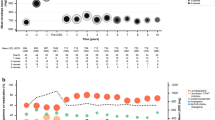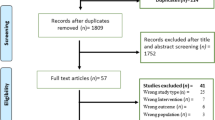Abstract
During the last few years, deep brain stimulation (DBS) of the subthalamic nucleus (STN) has emerged as a promising therapy, alleviating major motor symptoms of Parkinson’s disease (PD). However, in times of growing budgetary limitations, medical decisions are no longer merely based on clinical efficacy, but also on cost-effectiveness. Here we assess treatment costs (i. e. costs for conservative pharmacological treatment and all in-patient admissions) of 46 PD patients for one year before and two years after STN-DBS. The present data show that total treatment costs were increased by 32 % for the first year and decreased by 54 % for the second year of STN-DBS in comparison with preoperative values while the Unified Parkinon’s Disease Rating Scale (UPDRS III) was significantly improved. The increase for the first year after surgery was mainly due to the implantation of the STN electrodes and the stimulation device. Taken together, STNDBS pays off from the second year of stimulation while motor symptoms are significantly improved. The present study provides first data of an important number of patients on clinical effectiveness and expenses in relation to STNDBS.
Similar content being viewed by others
References
Benabid AL, Pollak P (2000) Cost assessment of functional neurosurgery for abnormal movement by stimulation of the basal nuclei, particularly the subthalamic nucleus. Rev Neurol (Paris) 156(Suppl 2)Pt 2:270–273
Blumenschein K, Johannesson M (1996) Incorporating quality of life changes into economic evaluations of health care: an overview. Health Policy 36:155–166
Bundesverband der pharmazeutischen Industrie, Rote Liste, Rote Liste Verlag, Weinheim, 2002
Burchiel KJ, Anderson VC, Favre J, Hammerstad JP (1999) Comparison of pallidal and subthalamic nucleus deep brain stimulation for advanced Parkinson’s disease: results of a randomized, blinded pilot study. Neurosurgery 45:1375–1382
Dodel RC, Berger K, Oertel WH (2001) Health-related quality of life and healthcare utilisation in patients with Parkinson’s disease: impact of motor fluctuations and dyskinesias. Pharmacoeconomics 19:1013–1038
Ehringer H, Hornykiewicz O (1960) Verteilung von Noradrenalin und Dopamin (3-Hydroxytyramin) im Gehirn des Menschen und ihr Verhalten bei Erkrankungen des extrapyramidalen Systems. Klin Wochenschr 38:1236–1239
Fahn S, Elton RL (1987) Committee MotUD: Unified Parkinson’s Disease Rating Scale. In: Fahn S, Marsden CD (eds) Recent developments in Parkinson’s disease. Florham Park, Macmillan Health Care, pp 153–164
Krack P, Batir A, Van Blercom N, Chabardes S, Fraix V, Ardouin C, Koudsie A, Limousin PD, Benazzouz A, Lebas JF, Benabid AL, Pollak P (2003) Five-year follow-up of bilateral stimulation of the subthalamic nucleus in advanced Parkinson’s disease. N Engl J Med 349:1925–1934
Krack P, Limousin P, Benabid AL, Pollak P (1997) Chronic stimulation of subthalamic nucleus improves levodopa-induced dyskinesias in Parkinson’s disease. Lancet 350:1676
Kumar R, Lozano AM, Kim YJ, Hutchison WD, Sime E, Halket E, Lang AE (1998) Double-blind evaluation of subthalamic nucleus deep brain stimulation in advanced Parkinson’s disease. Neurology 51:850–855
Lang AE, Widner H (2002) Deep brain stimulation for Parkinson’s disease: patient selection and evaluation. Mov Disord 17(Suppl 3):S94–S101
Laupacis A, Feeny D, Detsky AS, Tugwell PX (1992) How attractive does a new technology have to be to warrant adoption and utilization? Tentative guidelines for using clinical and economic evaluations. Can Med Assoc J 146:473–481
Limousin P, Krack P, Pollak P, Benazzouz A, Ardouin C, Hoffmann D, Benabid AL (1998) Electrical stimulation of the subthalamic nucleus in advanced Parkinson’s disease. N Engl J Med 339:1105–1111
Mandelblatt JS, Fryback DG, Weinstein MC, Russell LB, Gold MR (1997) Assessing the effectiveness of health interventions for cost-effectiveness analysis. Panel on Cost-Effectiveness in Health and Medicine. J Gen Intern Med 12:551–558
Marsden CD, Parkes JD, Quinn N (1982) Fluctuations of disability in Parkinson’s disease—clinical aspects. In: Marsden CD, Fahn S (eds) Neurology 2: Movement Disorders. London, Butterworth Scientific, pp 96–122
Meissner W, Hill M, Tison F,Gross CE, Bezard E (2004) Neuroprotective strategies for Parkinson’s disease: conceptual limits of animal models and clinical trials. Trends Pharmacol Sci 25:249–253
Moro E, Scerrati M, Romito LM, Roselli R, Tonali P, Albanese A (1999) Chronic subthalamic nucleus stimulation reduces medication requirements in Parkinson’s disease. Neurology 53:85–90
Rodriguez-Oroz MC, Gorospe A, Guridi J, Ramos E, Linazasoro G, Rodriguez-Palmero M, Obeso JA (2000) Bilateral deep brain stimulation of the subthalamic nucleus in Parkinson’s disease. Neurology 55:S45–S51
Shils JL, Miravite J, Tagliati M, Alterman RL (2002) Economic impact of the reduction in medication requirements after STN deep brain stimulation in Parkinson’s disease. Mov Disord 17(Suppl 5):S194
Spottke EA, Volkmann J, Lorenz D, Krack P, Smala AM, Sturm V, Gerstner A, Berger K, Hellwig D, Deuschl G, Freund HJ, Oertel WH, Dodel RC (2002) Evaluation of healthcare utilization and health status of patients with Parkinson’s disease treated with deep brain stimulation of the subthalamic nucleus. J Neurol 249:759–766
Tomaszewski KJ, Holloway RG (2001) Deep brain stimulation in the treatment of Parkinson’s disease: a costeffectiveness analysis. Neurology 57:663–671
Volkmann J, Allert N, Voges J, Weiss PH, Freund HJ, Sturm V (2001) Safety and efficacy of pallidal or subthalamic nucleus stimulation in advanced PD. Neurology 56:548–551
Author information
Authors and Affiliations
Corresponding author
Rights and permissions
About this article
Cite this article
Meissner, W., Schreiter, D., Volkmann, J. et al. Deep brain stimulation in late stage Parkinson’s disease: a retrospective cost analysis in Germany. J Neurol 252, 218–223 (2005). https://doi.org/10.1007/s00415-005-0640-3
Received:
Revised:
Accepted:
Issue Date:
DOI: https://doi.org/10.1007/s00415-005-0640-3




